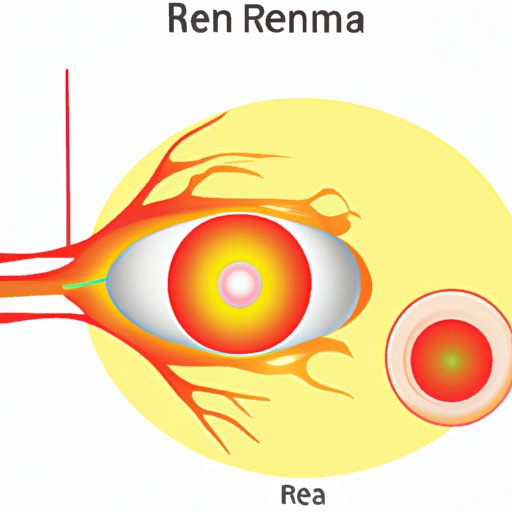Introduction
The retina is a thin layer of tissue located in the back of the eye that is responsible for transforming light into signals that can be interpreted by the brain. It is an integral part of vision and without it, we would not be able to see. In this article, we will explore the anatomy of the retina, how it works, and its various functions.
Exploring the Anatomy of the Retina: How Does it Work?
The anatomy of the retina is complex, but understanding it can help us to better understand how it works. The retina is made up of several different layers, each with its own unique set of cells and structures.
The most important part of the retina are the photoreceptor cells. These cells are responsible for converting light into electrical signals that can be interpreted by the brain. There are two types of photoreceptors: rods and cones. Rods are sensitive to low levels of light and are responsible for black-and-white vision. Cones are more sensitive to bright light and are responsible for color vision.
In addition to the photoreceptor cells, the retina also contains ganglion cells, which transmit signals from the photoreceptor cells to the brain. The retina also contains amacrine cells, which help to modulate the signals sent to the brain, as well as horizontal cells, which help to adjust the sensitivity of the photoreceptor cells. Finally, the retina contains the pigmented epithelium, which helps to protect the photoreceptor cells from damage.

A Deeper Look at How the Retina Works
To understand how the retina works, we must first understand how light enters the eye and is processed by the retina. When light enters the eye, it passes through the cornea and lens and is focused onto the retina. The photoreceptor cells then absorb the light and convert it into electrical signals. These signals are then sent to the ganglion cells, which transmit them to the brain.
Once the signals reach the brain, they are interpreted as images. This process happens incredibly quickly and is essential for our ability to see. Without the retina, light would not be able to enter the eye and be converted into signals that the brain can interpret.
An Overview of the Retina and Its Function
The retina is responsible for several important functions. First, it converts light into electrical signals that can be interpreted by the brain. Second, it helps to adjust the focus of the eye, allowing us to see clearly. Third, it helps to adjust the brightness and contrast of what we see. Finally, it helps to regulate our circadian rhythm, helping us to maintain a regular sleep cycle.
The retina is also essential for our ability to see clearly. Without it, we would not be able to distinguish between colors or perceive depth. Additionally, diseases and disorders of the retina can lead to vision loss, so it is important to understand how it works and take steps to protect it.
The Science Behind the Retina: How Does It All Come Together?
The science behind the functioning of the retina is complex, but it can be broken down into several key principles. First, the retina is composed of specialized cells that convert light into electrical signals. Second, these signals are sent to the brain where they are interpreted as images. Third, the retina helps to adjust the focus of the eye and regulate brightness and contrast. Finally, it helps to control our circadian rhythm, ensuring that we get enough sleep.
Understanding the science behind the retina is essential for understanding how it works and why it is so important for our vision. Without it, we would not be able to see clearly or perceive depth.

Visualizing the Retina: How It Works to Process Sight
When we visualize the retina, we can get a better understanding of how it works to process visual information. When light enters the eye, it is absorbed by the photoreceptor cells and converted into electrical signals. These signals are sent to the brain where they are interpreted as images. The retina also helps to adjust the focus of the eye, regulate brightness and contrast, and control our circadian rhythm.
Unfortunately, diseases and disorders of the retina can have a significant impact on our vision. For example, macular degeneration is a common disorder of the retina that can lead to vision loss. It is important to understand the anatomy and function of the retina and take steps to protect it.
Conclusion
In conclusion, the retina is an essential part of our vision. It is a thin layer of tissue located in the back of the eye that is responsible for transforming light into signals that can be interpreted by the brain. Understanding the anatomy and function of the retina is essential for understanding how it works and why it is so important for our vision. Additionally, diseases and disorders of the retina can lead to vision loss, so it is important to understand how it works and take steps to protect it.
(Note: Is this article not meeting your expectations? Do you have knowledge or insights to share? Unlock new opportunities and expand your reach by joining our authors team. Click Registration to join us and share your expertise with our readers.)
